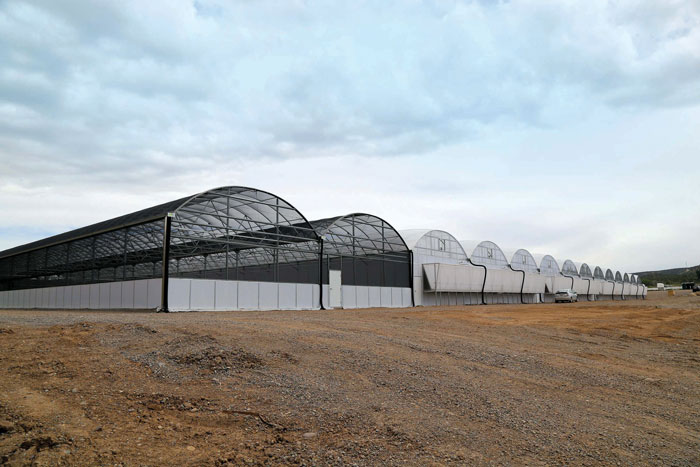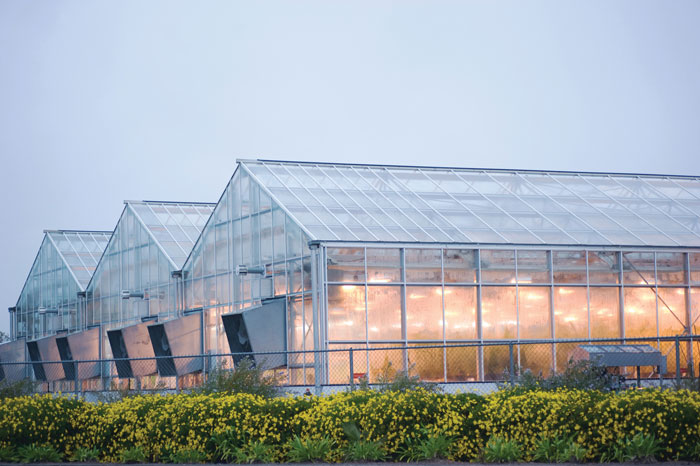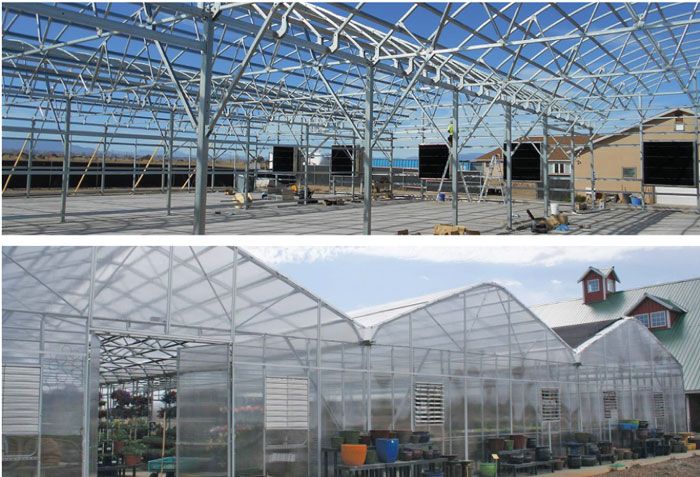11/1/2020
How to Scale as You Grow
Janine Coppola

One of the most exciting times for a business is when it begins to grow. Many greenhouse operations find themselves needing more space for their crops, but don’t know where to start with expanding their greenhouses. This seems like a daunting undertaking at first glance, involving overwhelming amounts of planning, miles of red tape and many moving parts.
The key to expanding a greenhouse grow operation is to have a clear plan from the start. Without considering future needs from the beginning, greenhouse expansion is rendered incredibly difficult. When an operation is first starting out, growers should be sure to account for future growth in every decision they make.
Pictured: Considering possible expansion when constructing a greenhouse can save operations time and money.
For example, consider greenhouse structures that are easy to add onto, allot for more power than is currently needed and explore automation options even if they aren’t currently necessary. These steps will help prepare a business for expansion in the future, and once they’re squared away, the real work can begin.
Structure
First and foremost, an operation needs to figure out how they’re going to physically expand their greenhouse. They need to consider how much additional space they need, where they want to add it and how conducive it will be to further expansion. This all depends on the type of greenhouse structure. Gutter-connect greenhouses are going to be significantly easier to expand upon than standalone structures, so if an operation is planning on continued expansion, this is the way to go.
Next, growers must take zoning and regulations into account. Growers should always consider the snow loads, wind loads and other weather factors that may affect their greenhouse. Municipalities will dictate if an operation needs to have stamped, engineered plans for their structure, so keep this in mind when planning an expansion.
 Zoning and regulations are an integral part of the expansion process, especially for cannabis operations. Cannabis operations tend to be faced with far more regulations than other growers, so they should be mindful of this when planning their expansion.
Zoning and regulations are an integral part of the expansion process, especially for cannabis operations. Cannabis operations tend to be faced with far more regulations than other growers, so they should be mindful of this when planning their expansion.
Pictured: To make sure structures stand up to local weather patterns, growers may need to obtain stamped engineered drawings.
Matt Sauls, a greenhouse specialist at GrowSpan Greenhouse Structures, has noticed in his extensive experience that cannabis operations tend to get caught in a lot of red tape.
“A lot of times in the cannabis world, I’ve seen they deal with more regulations rather than less,” he explained. “So, if it’s a cannabis structure, you’re probably going to need to do your research because you may be facing more work upfront to be able to get approval.”
One might think that a larger expansion would break the bank, but this isn’t necessarily the case. In fact, when an operation is building a larger expansion, the cost per square foot may actually decrease.
“Often people are pleasantly surprised at the cost per square foot,” Matt said. “That’s always a good thing and I think sometimes people are surprised about that, especially if they haven’t looked at those large construction projects.”
After deciding on an expansion size and looking into zoning and regulations, site preparation needs to be done.
“You certainly want a mostly flat area, so if you don’t have that, you’ll have to do some site work,” said Matt. “Maybe some grading, maybe bringing in some fill, just so you have a nice flat surface.”
Electricity
The key to any greenhouse expansion is planning from the very beginning of the operation. When starting out, growers need to account for expansion in the future, especially pertaining to electricity. Without the proper preparation, growers may not be able to obtain enough power up front to allow for expansion in the future. For this reason, it’s important to consider future needs rather than present needs when beginning the planning process for a growing operation.
“I’ve seen situations in commercial grows where they want to expand, they want to build out, but they cannot get any more power because they just don’t have the infrastructure for it yet,” Matt said. “So you can always get upgrades later based on the amp load you need, but I think it’s a good idea to look to the future and see that you may need a little bit more power than you do right now.”
This can save growers time and money, and will be worthwhile in the future.
It’s also worthwhile for growers to look into renewable and sustainable energy as supplementary sources of energy for their operation. Not only are things like solar and geothermal energy good for the environment, but some electric companies even offer rebates for using them.
“I think if they have any sorts of programs or rebates for maybe energy efficiency or more sustainable solutions they should look into that,” Matt said. “Greenhouses are really substantially less expensive to operate energy-wise compared to, maybe, an indoor grow, and so there’s advantages there, and some energy companies are incentivizing that.”
In addition to renewable energy, some automated technology can qualify for rebates as well.
Automation
With an expanding business, growers might think that their operating costs are going to increase. Luckily, this isn’t necessarily the case. If growers implement automation in their structures, they may be pleasantly surprised at their energy consumption and operating costs.
“A great portion of your overhead is going to be energy, and a great portion of your overhead is going to be labor, and you want to minimize both of these at every turn,” Matt explained. “So having smart controls or a smart greenhouse is going to save you far more than it will add, in my experience, to any cost.”
Automating certain processes and equipment ensures that different aspects of your grow—such as lighting, irrigation or heating—are only turned on when they’re needed, thus conserving energy. It also eliminates the need for employees to operate these systems, so labor can be focused elsewhere.
 Pictured top: Planning and site prep is an important first step when looking to expand.
Pictured top: Planning and site prep is an important first step when looking to expand.
Bottom: Investing in gutter-connect greenhouses can make expanding in the future much easier.
For automation to run smoothly, growers should get a controller that allows for expansion from the beginning of their operation. This is especially important with zones. A controller with a set number of zones won’t be good for an operation that’s planning on future growth. Some controllers are available that allow an operation to easily add zones as they need them, so these would be a better choice for a growing
operation.
“Just like with the other parts of an operation, sometimes it’s not a bad idea to plan for the future with your controller system,” Matt said. “Maybe you’re just starting off with two or three bays, but you want to double or triple that down the road. You’re going to want an integrated computer system that can expand and add in those new grow areas.”
Matt also emphasized the importance of well-integrated systems for potential expansion. “It’s certainly hard to work with systems that are not well integrated, as far as sensors or separate reservoirs,” he said. “It may be great as a standalone or maybe in a small operation, but it might not be the best thing to expand if you’re going to be running tens of thousands of different systems simultaneously. It’s just going to be an enormous undertaking.”
Automation will help with saving energy, but operations still need to have energy-efficient systems as well. Efficient heating and irrigation systems, for example, are always a good investment. Hydronic heating and boiler units are low cost to operate and help growers conserve energy. Some secondary heating may be required, but overall, hydronic heating is very efficient and easily expanded upon.
For irrigation, Matt mentions ebb-and-flow systems for expanding operations.
“Ebb-and-flow systems are very easy to expand without a lot of time and effort,” he explained. “There certainly is some work on the front end that has to be done, but once you dial that in, you can just sort of cookie-cutter expand it and just follow that same model.”
Drip irrigation systems are also easily expanded and many growers already have these systems in place. All expansion involves is running extra line, so it really comes down to having the time to put the work in. In addition to easy expansion, all of these systems can also be automated, streamlining an operation even further.
Expanding an operation is a large undertaking, but it doesn’t have to be as daunting as it seems. It’s almost always beneficial to a business, as it provides more space for growing and opportunities for improvements to existing operations and increased automation.
Essentially, when considering anything for a greenhouse, always think of its scalability.
“I think that often people may expect certain methods and technologies to scale to new heights in their business, and then they realize those aren’t very practical at a larger scale,” Matt said. “So you want to make that distinction when you’re looking at potential technologies and systems. Always think, ‘Is this going to scale for me?’ You don’t want to have the unpleasant surprise later on that this system you’re devoted to and stuck with is not going to help efficiently scale your business.” GT
Janine Coppola works for GrowSpan Greenhouse Structures. For over 40 years, GrowSpan has been providing the horticulture industry with high-quality growing structures. For more information, visit GrowSpan.com.